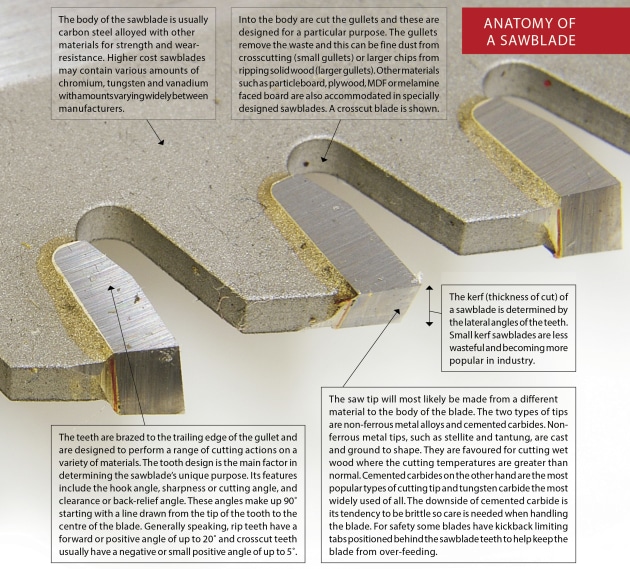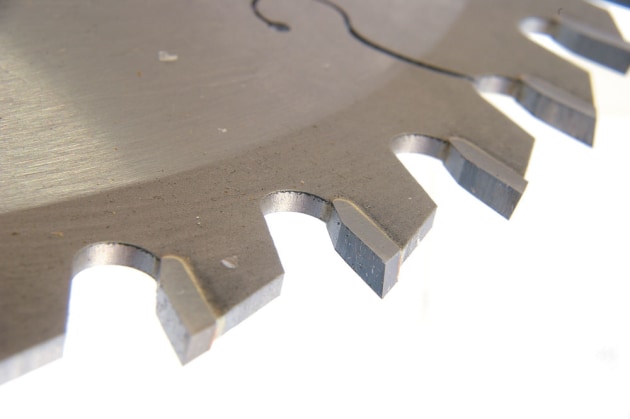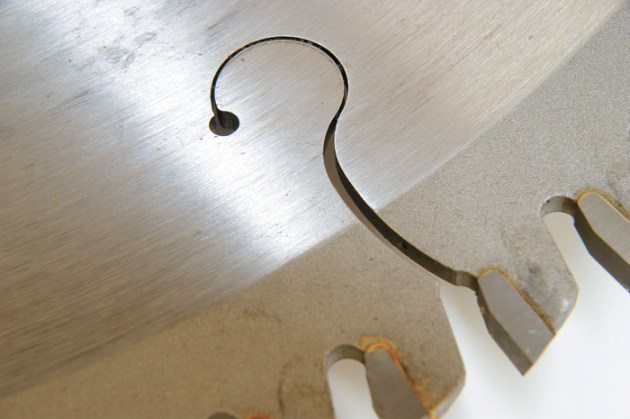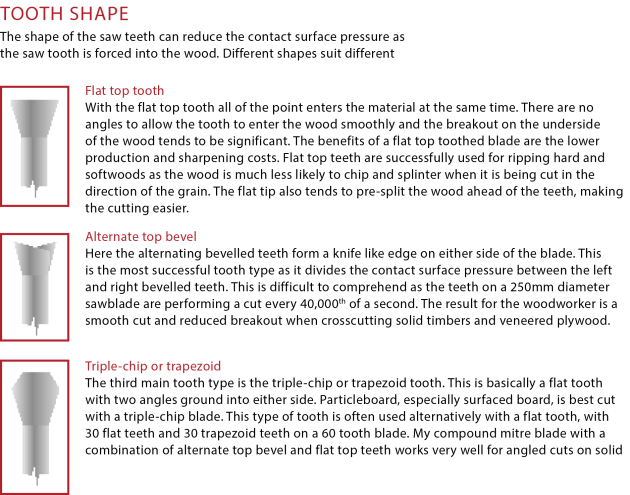Choosing the right circular sawblade
Words: Philip Ashley
Photos: Rebecca Nathan
Circular sawblades are the most complex of all the cutting tools. Available in various sizes, these steel discs have a number of shaped teeth around the periphery and a hole in the centre to fit a machine drive shaft. It’s the teeth that give each blade its distinctive capabilities that make it unique. No sawblade does everything well. Each blade incorporates a specific tooth style, gullet, tooth angle and materials designed specifically for a single function.
So, a crosscut blade must not be used to rip wood and a ripsaw blade must not be used to make a crosscut. Doing either is inefficient and in some cases dangerous. The combination blade is a compromise that trades the cost of numerous purpose-made sawblades for fewer blades with combined functions. What must be remembered is that the compromise includes the efficiency and quality of the finished cut. In general, blades with more teeth give a smoother cut, and blades with fewer teeth remove material faster. Crosscut saws usually have more teeth than ripsaws.
Crosscut blades
The crosscut sawblade is designed to sever the fibres of the wood. One tooth severs the fibres on the left of the kerf and the following tooth severs the fibres on the right. The waste in the middle is drawn away into the dust extraction. Crosscut blades are designed to eliminate breakout on the underside of the wood. The small hook angle of the tooth reduces this breakout and eliminates any grabbing effect. As the crosscut saw usually cuts from the top and towards the fence, there is a tendency for the teeth to grab the wood fibres and accelerate the blade towards the operator. Blunt teeth make this tendency far worse. When using crosscut machinery, take care to use sharp blades. Carefully control the movement of the sawblade through the wood and never attempt to force the cut. Excessive feed speed can lead to a nasty experience. Never have any part of your body in the line of the cut and you should remain injury free.

Ripsaw blades
The ripsaw blade is designed to divide a wooden board from end to end. To do this the blade must remove a narrow strip of wood referred to as the kerf from the board. This strip is made up of wood fibres that cling together and must be chiselled from the length of the board. The chips must be taken away as waste by the large gullets and emptied into the dust extraction in preparation for the next revolution of the blade. The cut must be clean and allow clearance to the body of the blade.
The teeth cut in a downward action, slightly towards the operator and at great speed. Any problem with the blade and the machine has the potential to cause a serious incident. The speed of the saw teeth is so great as to potentially create a missile of the wood if something goes amiss. When ripsawing solid wood, make sure the guards are in place and set correctly. The sawblade should be sharp and the riving knife set correctly* to stop the wood from closing on the back of the blade. The correct blade should always be used and you should never stand immediately behind the sawblade. If the blade tends to grab the wood, carefully pull the wood back until it releases, then continue the rip cut. The sawblade should re-cut the kerf that has closed on the blade.
Using the right blade correctly will save money and increase the life of your expensive sawblades. To put together a decent sawblade collection you need to know a little about the various features of a modern sawblade and what each sawblade type does best.
Sawblade performance
The sawblade itself has very little lateral strength, most of its power coming from the tremendous force exerted by the great speed of the saw teeth. A 250mm diameter sawblade on a small combination machine spinning at 4,000rpm would travel at almost 190 kilometres an hour at the tip. Anything coming off this blade will be travelling at something approaching this speed. Along with this speed comes a significant amount of heat. This heat is generated by the friction of the teeth as they slice through the wood at 240,000 teeth a minute. Add to this the effect of heating up the moisture in the wood and you get quite a combination of forces happening at the one time.
Circular sawblades are used on tablesaws, drop saws and radial arm saws. There are a number of essential elements for their safe and efficient operation. While sawblade design has been refined over the last 40 years or so, the mechanical function of a circular saw has remained the same. The sawblade still spins at great speed. The blade still impacts the wood and either chisels or parts the wood fibres. The waste is still held in a gullet and disposed of into the dust extraction. You should be aware of the following.
Bore tolerance
The sawblade when cutting will not be perfectly round. There is no way to exactly fit a 30mm bore sawblade onto a 30mm spindle and there is always some small difference to allow the blade to fit, no matter what you have been told. To minimise any difference, the bore of the sawblade must be as close to the spindle size of your machine as possible. More expensive sawblades have higher tolerances and may fit better. Any large difference here will result in the blade running out of round and cause only a few of the teeth to cut effectively. If you want to fit a 30mm bore sawblade to a 20mm spindle you can always get a sleeve to take up the difference, but every little variation adds up to poor performance.
Heat
The sawblade will generate heat as it cuts the wood. How much heat will depend on several factors including the condition and type of blade, the material being sawn and the moisture content of the wood. The centre of the blade will be the same temperature as the motor, about 80˚C. At the periphery of the blade the temperature can reach over 400˚C! Expansion slots built into the saw body will allow the blade to expand at the outside.
Noise
The sawblade will generate noise. Noise is a factor that you cannot ignore, especially if you work from home. The movement of air at high speeds creates noise. It can be reduced by the design of the saw gullet and with the addition of either laser cut grooves in the body of the sawblade, or by a dampening treatment. Laser-cuts are the cheaper option and are provided on some good quality blades. Crosscutting blades are more prone to high noise levels and dampening is often provided on industrial crosscutting blades.
Maintenance
Your sawblades will benefit from a little TLC. Cleaning the blade can result in as much as a 15% increase in efficiency! You will use less power to drive the saw through the wood and reduce the operating temperature of the saw tip. There is some evidence that organic acids contribute to sawblade steel corrosion so cleaning the blade regularly makes sense. The gullets if clogged may increase the tendency for the sawblade to crack from the base of the gullet.
Sharpening the blade regularly will ensure that the blade always operates at peak efficiency. A dull blade will not perform well, the cut will not be as good as it could be and the blade will wear out more quickly. Never run your blade after it gets blunt because sharpening an overly dull blade will require the saw doctor to remove far more of your expensive cutting material than necessary to achieve a sharp edge. Use the correct blade for the job, keep your sawing machine in good condition and you will find yourself sawing safely and more efficiently.
First published in Australian Wood Review magazine, issue 57, December 2007






